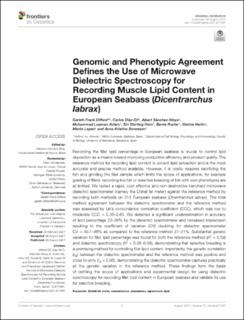| dc.description.abstract | Recording the fillet lipid percentage in European seabass is crucial to control lipid deposition as a means toward improving production efficiency and product quality. The reference method for recording lipid content is solvent lipid extraction and is the most accurate and precise method available. However, it is costly, requires sacrificing the fish and grinding the fillet sample which limits the scope of applications, for example grading of fillets, recording live fish or selective breeding of fish with own phenotypes are all limited. We tested a rapid, cost effective and non-destructive handheld microwave dielectric spectrometer (namely the Distell fat meter) against the reference method by recording both methods on 313 European seabass (Dicentrarchus labrax). The total method agreement between the dielectric spectrometer and the reference method was assessed by Lin’s concordance correlation coefficient (CCC), which was low to moderate CCC = 0.36–0.63. We detected a significant underestimation in accuracy of lipid percentage 22–26% by the dielectric spectrometer and increased imprecision resulting in the coefficient of variation (CV) doubling for dielectric spectrometer CV = 40.7–46% as compared to the reference method 27–31%. Substantial genetic variation for fillet lipid percentage was found for both the reference method (h2 = 0.59) and dielectric spectroscopy (h2 = 0.38–0.58), demonstrating that selective breeding is a promising method for controlling fillet lipid content. Importantly, the genetic correlation (rg) between the dielectric spectrometer and the reference method was positive and close to unity (rg = 0.96), demonstrating the dielectric spectrometer captures practically all the genetic variation in the reference method. These findings form the basis of defining the scope of applications and experimental design for using dielectric spectroscopy for recording fillet lipid content in European seabass and validate its use for selective breeding. | |
